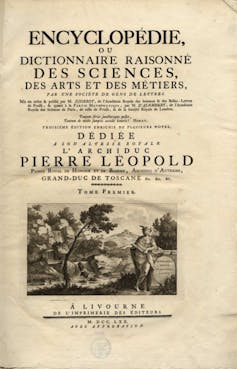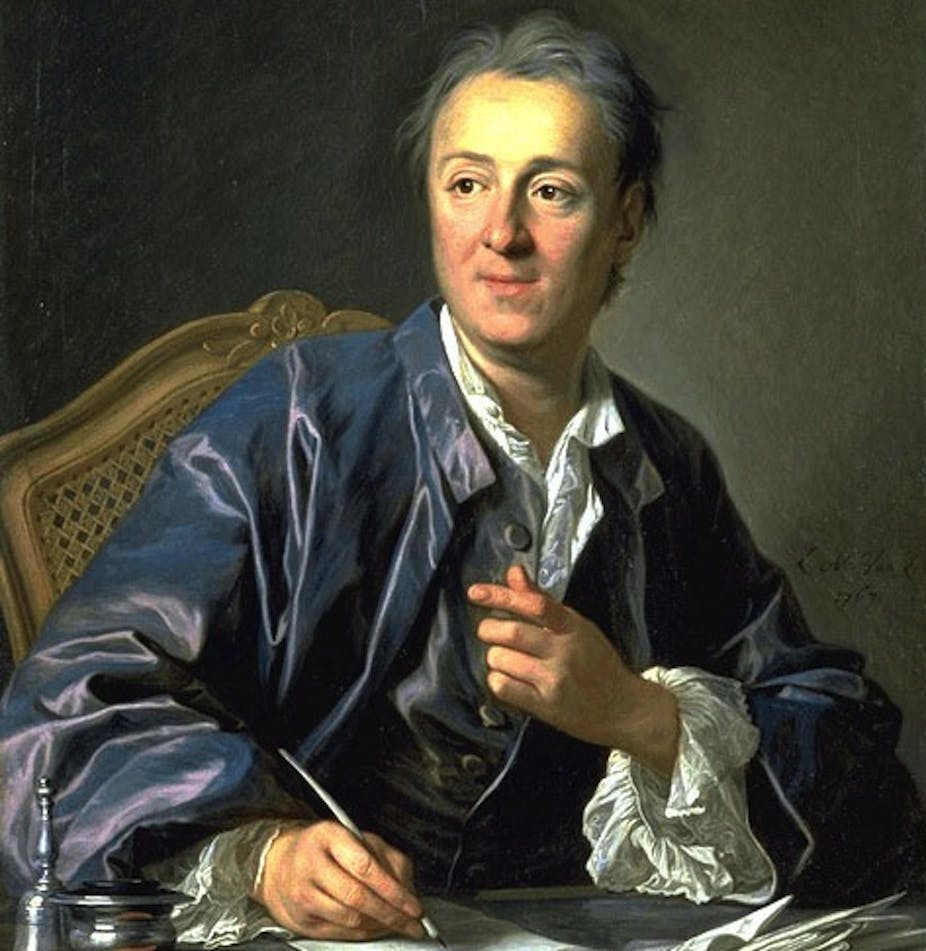Today (October 5) is 300 years since the birth of Denis Diderot, a prominent Enlightenment philosopher, art critic, and writer, who died on July 31, 1784, aged 70. A key Enlightenment figure, many of Diderot’s ideas were avant-garde and foreshadowed many concepts in modern science.
Diderot was not a practising scientist, but was as close to one as he could be. His first major publication was a translation and commentary of an English medical dictionary.
Later, he declared “there are few works I read with more pleasure than medical works”. He also spent several years attending the chemistry lectures of Guillaume-François Rouelle, one of France’s most prominent 18th-century chemists.
Diderot wrote some respectable papers on probabilities. And he later produced an impressive, unfinished work over at least 15 years – the Elements of Physiology (1770s).

In that book, he tries to work out the consequences for our picture of human nature, memory, mind and action, of evolving scientific knowledge coming from physiology, medicine and anatomy (including of the brain).
Most famously, Diderot was the co-editor (and later sole editor) of the mammoth Encyclopedia, the first systematic, collective enterprise designed to organise all our knowledge of the sciences, arts and technology in a format accessible to the “educated everyman”.
Science or philosophy?
But Diderot’s status as either a predecessor of developments in the sciences, or a kind of “scientific theorist” is also strongly affected by his brilliant works of experimental philosophical prose.
Some of these read like novels, some like philosophical dialogues, and some are just unclassifiable.
They include the Letter on the Blind and the Letter on the Deaf and Mute (late 1740s-early 1750s); Thoughts on the Interpretation of Nature (1753); and D’Alembert’s Dream (1769).
The Letter on the Blind takes the pretext of an actual blind mathematician to investigate Molyneux’s Problem (if a person born blind, with an understanding of basic mathematics, recovered her sight and saw a cube, would she instantly know what it was?), and has been called a “turning point in Western attitudes to disability”.

But beyond that, it turns empiricism on its head, moving from the idea that our knowledge comes (mainly) from our senses to an actual metaphysics of the senses, where smell, sight, taste, touch and sounds each open onto a world.
D’Alembert’s Dream
Diderot’s most scientifically creative work is D’Alembert’s Dream, which has an average of one speculative new scientific hypothesis per page (sometimes none, but sometimes five or ten).
One of these hypotheses is that not only can matter think, but all of matter senses. At the very beginning of the dialogue, the character D’Alembert challenges the character Diderot, asserting that everyone knows thought and matter are different.
The character Diderot responds with a thought experiment of a marble statue, ground into powder, mixed into the earth, out of which plants grow, which animals eat. In turns the animals are eaten by us – what Diderot calls the “animalisation” of matter.
Thus the difference between a piece of marble and a sensing, conscious creature is a difference in temporal stages of a portion of matter. (He thinks if this can be granted, thought itself just follows from sensation.)
But for this to be true, we definitely need a conception of matter different from that of 17th-century mechanics.

This is why, in the same work, Diderot appeals to the new biological (specifically, embryological) theory of epigenesis, according to which living beings are formed in the womb by the gradual layering of material substance, without any preformed “information” or “soul”.
What is unusual is that he turns this biological theory into a metaphysics of matter itself, perpetually transforming and evolving, full also of monsters.
This led some commentators later on to consider him as a “precursor of Darwin,” a view which is less fashionable now.
Diderot and the brain
A final remark, on the brain. Materialist neurophilosophy (the core idea of which is that the mind is the brain, or better, that mental processes are cerebral processes) sometimes, like any human endeavour, looks back to find its historical predecessors.
Some people pick Julien Offray de La Mettrie, whose Man a Machine (1748) is not unlike some of Diderot’s writing.
But in his Elements of Physiology, Diderot has a more subtle thought – “the soft substance of the brain” is “like a mass of sensitive and living wax, which can take on all sorts of shapes, losing none of those it received,” when adding new ones.
He says it is like a book:
But where is the reader? The reader is the book itself. For it is a sensing, living, speaking book.
So, the brain is like a book which reads itself – that’s really quite unusual for the 18th century.

Diderot both “discovered” materialism and anticipated one of its main problems – how to do justice to the difference between a living, working brain, embedded in society and culture, and a liver or a kidney.
Diderot was an original “scientific theorist” of the Enlightenment, who connected the newest scientific trends to radical philosophical ideas such as materialism. He was especially interested in the life sciences and their impact on our traditional ideas of what a person – or humanity itself – are.
If he were alive today, well … Diderot would be excited but also worried by fields such as “neuroethics”, “neurolaw”, and evolutionary psychology, attempts to explain people’s behaviour – current and future – from brain scans. Similarly with human genetic enhancement and projects like Google’s venture into medicine.
He would never reject scientific change outright (in the name of human dignity or the immortal soul). But he would worry about possibly warped views of what a person is, and hope for explanations that do justice to our own aesthetic, political, moral, creative urges as individuals and as citizens.

